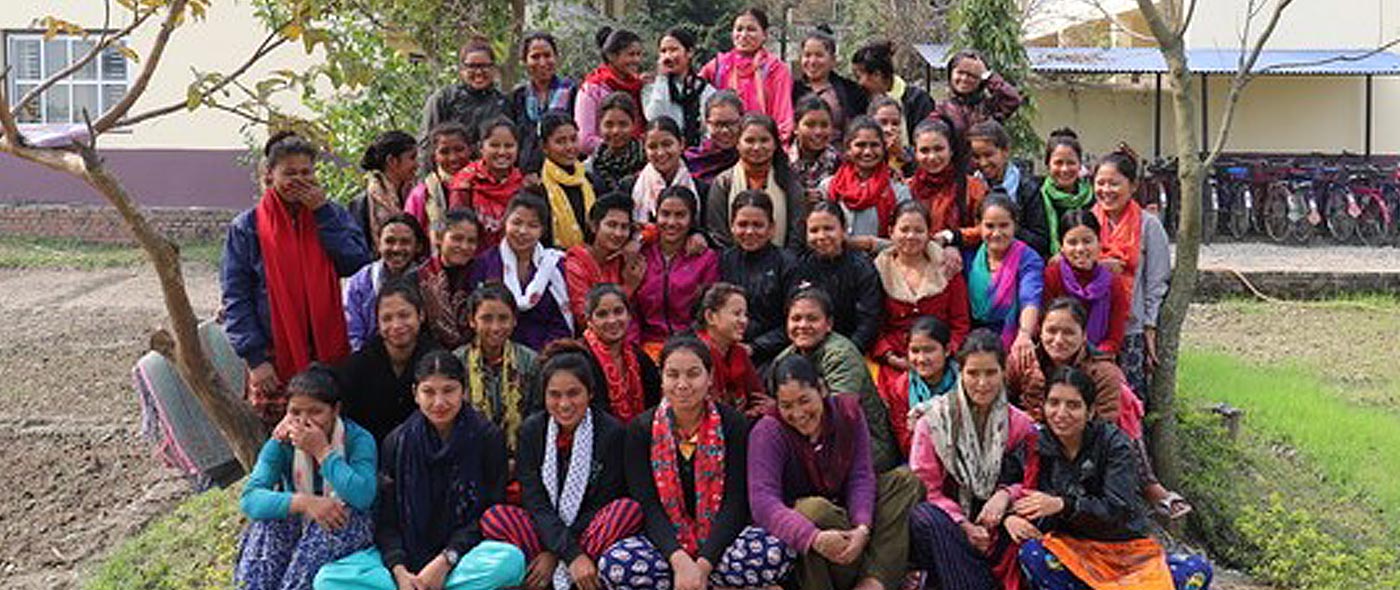Text: Bo Sigeback
Photos: Anette Axelsson och Bo Sigeback
At the end of January 2010, two Lions members traveled to Nepal to visit the school. The purpose was to create a basis for an evaluation of the school's status and to meet the students and thereby better inform the sponsors.
We who traveled were Anette Axelsson and Bo Sigeback. I, Anette, have been involved in the project from the beginning. My role is to hold the sponsoring activities together. This requires that I have good knowledge of the students. I will translate this knowledge into information that the sponsors expect to receive, but also information that allows us to continuously recruit new sponsors. I am also responsible for ensuring that the sponsoring contributions reach the school.
I, Bosse, am the Lions Advisor with the task of continuously supporting the school's Nepalese board and its staff at the school. It is also of great importance that I am well informed about the factual circumstances and the status of the school.
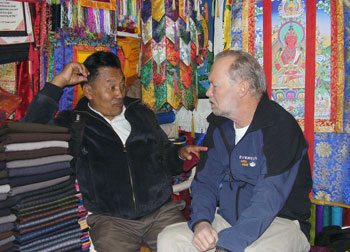 We also met the initiator of the school project, Lions member Claes Löfstedt (pictured with Temba Lama, our contact in Nepal when we bought fabrics for the school) who was on a personal visit to Nepal while preparing to receive Swedish travelers. Claes has been a tour guide for decades with in-depth knowledge of Nepal as one of his specialties.
We also met the initiator of the school project, Lions member Claes Löfstedt (pictured with Temba Lama, our contact in Nepal when we bought fabrics for the school) who was on a personal visit to Nepal while preparing to receive Swedish travelers. Claes has been a tour guide for decades with in-depth knowledge of Nepal as one of his specialties.
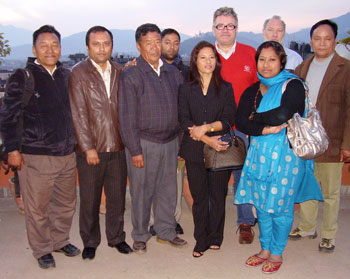 After two days in the capital Kathmandu, including a fruitful meeting with the school board (pictured left) and Claes Löfstedt, we took a local bus for just over 12 hours and reached Odari and the school late in the evening. Staff and students greeted us with flower necklaces, a delicious meal and a dance performance. We felt truly welcome.
After two days in the capital Kathmandu, including a fruitful meeting with the school board (pictured left) and Claes Löfstedt, we took a local bus for just over 12 hours and reached Odari and the school late in the evening. Staff and students greeted us with flower necklaces, a delicious meal and a dance performance. We felt truly welcome.
But after a short conversation with students and staff, the power went out and we had to grope our way to the beds, light a candle and then unpack the contents of our bags. Bosse's bag contained, above all, many games from Alga, balloons, Lions Red Feathers and gifts for his goddaughter. Anette had lots of fabrics and samples of things that the students might be able to sew in the next few days?
After a good night's sleep, we are woken up at seven by the sound of the food gong-gong. Already at 5, four students get up and help Chef Ongchhu prepare breakfast. The other students were already up when we woke up. Everyone gets up at 6, washes up and does their homework in case the power went out the night before.
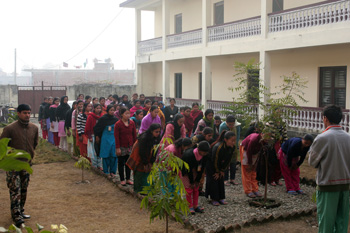 After breakfast, it's time for the morning assembly. Since they don't have a room that can accommodate all the students at the same time, it takes place outdoors. They line up in four lines with one student in front of them all. She leads the assembly with the assistance of the teacher Sonam Sherpa. The students do gymnastic movements, especially for the wrists, knees and ankles, all to make the sewing lessons easier. They then sing the national anthem and finish with 5 minutes of yoga. Then half of the students go to the sewing room and the other to the two English classrooms. The English teacher, Sonam Sherpa, works with the students in two groups. Half the time is teacher-led and the other half is self-study. My impression is that this works well as the students are eager to learn as much as possible. The students support each other so much that if one of the girls cannot answer Sonam's question directly, you can hear their peers whispering to help with the answer.
After breakfast, it's time for the morning assembly. Since they don't have a room that can accommodate all the students at the same time, it takes place outdoors. They line up in four lines with one student in front of them all. She leads the assembly with the assistance of the teacher Sonam Sherpa. The students do gymnastic movements, especially for the wrists, knees and ankles, all to make the sewing lessons easier. They then sing the national anthem and finish with 5 minutes of yoga. Then half of the students go to the sewing room and the other to the two English classrooms. The English teacher, Sonam Sherpa, works with the students in two groups. Half the time is teacher-led and the other half is self-study. My impression is that this works well as the students are eager to learn as much as possible. The students support each other so much that if one of the girls cannot answer Sonam's question directly, you can hear their peers whispering to help with the answer.
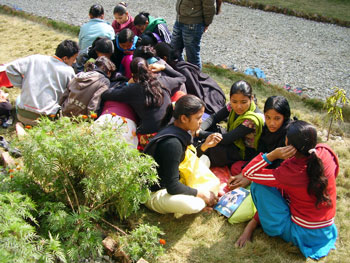 During breaks, the girls sit in small groups to read English, chat or play board games, the latter especially since we have brought in e.g. Chinese chess, fox game, sudoku etc. We often saw that the teachers have good contact with the students during these breaks. They are happy to sit together with the students and spend time with them in a friendly way. This also applies to the cooks and the cleaner Indira who is also a housewife and a backup mother for many of the girls.
During breaks, the girls sit in small groups to read English, chat or play board games, the latter especially since we have brought in e.g. Chinese chess, fox game, sudoku etc. We often saw that the teachers have good contact with the students during these breaks. They are happy to sit together with the students and spend time with them in a friendly way. This also applies to the cooks and the cleaner Indira who is also a housewife and a backup mother for many of the girls.
What makes us particularly happy is that everyone is so supportive of each other. We do not notice any tendencies towards bullying or exclusion during our visit. The friendliness in the meetings with us is very tangible, as is the curiosity. They quickly learn that we like a little sun on our pale faces. This constantly leads to them moving tables and chairs, everything to meet our expectations of turning their faces towards the sun for a little while during the lunch break. When the plate is empty, they ask to take it and soon a new small dish arrives. Or the question comes: “Coffee or tea, Madame Anette?” “With milk or black, Sir Bo?” Have we never felt so courted? Everything happens with a little smile on our faces.
Speaking of smiles, their dental health is impressively good. They have practically no cavities. I'm not known for being so shy, so I kindly ask to look into one of the girls' mouths. I only see white, beautiful teeth. When I show my teeth with some amalgam fillings, I hear pitying and comforting words: "Oh, poor you, how can this happen? I hope it doesn't hurt?"
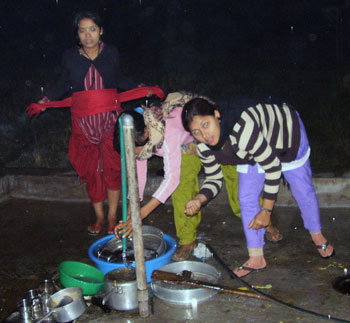 They don't eat any sweets at all and brush their teeth diligently. We know that they eat almost only rice and lentil soup. They drink water with this. The combination is called Dalbat and is the national dish in Nepal. In the village of Odari there is plenty of water and from the school's outdoor water tap pure, fine water flows without interruption, constantly and steadily. At the tap people wash clothes, do dishes, brush their teeth and wash their hair. The surplus from the tap flows out into the rice fields or the vegetable garden. With a few small earth embankments the direction of the water is easily changed.
They don't eat any sweets at all and brush their teeth diligently. We know that they eat almost only rice and lentil soup. They drink water with this. The combination is called Dalbat and is the national dish in Nepal. In the village of Odari there is plenty of water and from the school's outdoor water tap pure, fine water flows without interruption, constantly and steadily. At the tap people wash clothes, do dishes, brush their teeth and wash their hair. The surplus from the tap flows out into the rice fields or the vegetable garden. With a few small earth embankments the direction of the water is easily changed.
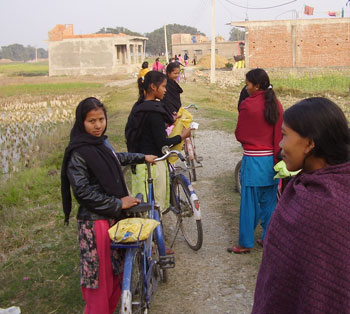 When the day's lessons are over, half of the students cycle home. Those who have a longer journey than an hour by bike live at the school, 24 hours a day. Thanks to a sponsor from Hässleholm, there are bicycles for the girls. They cycle together to avoid contact with strange men. Some are met by male relatives to get a safe journey home. Some of the students have such a long way home that it takes three days to get there. Then they travel perhaps 12-15 hours by bus but then there is still two days of walking before they arrive. These students travel home 1-2 times per school year and live at the school with four students per room.
When the day's lessons are over, half of the students cycle home. Those who have a longer journey than an hour by bike live at the school, 24 hours a day. Thanks to a sponsor from Hässleholm, there are bicycles for the girls. They cycle together to avoid contact with strange men. Some are met by male relatives to get a safe journey home. Some of the students have such a long way home that it takes three days to get there. Then they travel perhaps 12-15 hours by bus but then there is still two days of walking before they arrive. These students travel home 1-2 times per school year and live at the school with four students per room.
The four students form a group that, for example, takes care of the kitchen duty and spends a lot of time together. They are so composed that there are two first-year students and two second-year students. This is appreciated by the girls themselves as they get to know each other well and in many ways become good friends and peer supporters.
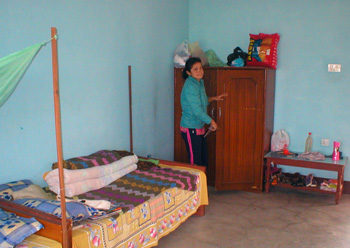 When we visit the girls, the beds are separated, but one of the girls tells us that at the beginning of January they moved all the beds next to each other so as not to freeze. It is between 10-15 degrees Celsius and humid during the worst winter nights and the school has no heating. In addition, there are 11 hours a day without electricity. Then the occasional candle is lit, but they are expensive. So you have to go to bed and wait for either daylight or electricity. It is like that all over Nepal. The electricity is not enough. The school has a diesel generator, but it is used as backup power during school hours, so that the 19 electric Japanese sewing machines can work. In addition, the school has 5 treadle sewing machines from China. The girls who have sewn at home before have only used treadle sewing machines. An electric sewing machine is a great luxury in a Nepalese home.
When we visit the girls, the beds are separated, but one of the girls tells us that at the beginning of January they moved all the beds next to each other so as not to freeze. It is between 10-15 degrees Celsius and humid during the worst winter nights and the school has no heating. In addition, there are 11 hours a day without electricity. Then the occasional candle is lit, but they are expensive. So you have to go to bed and wait for either daylight or electricity. It is like that all over Nepal. The electricity is not enough. The school has a diesel generator, but it is used as backup power during school hours, so that the 19 electric Japanese sewing machines can work. In addition, the school has 5 treadle sewing machines from China. The girls who have sewn at home before have only used treadle sewing machines. An electric sewing machine is a great luxury in a Nepalese home.
The power outages are of course very annoying and replacing the loss with electricity from the school's diesel generator is much more expensive. We note that they have many sunny days and that solar cells for electricity production should be evaluated. But in that case it needs to be a robust system that can withstand typhoons and persistent rain. As a complement, there should be rechargeable batteries for back-up.
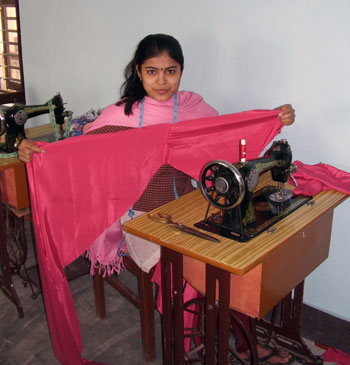 Most of the students would like to start a sewing studio after graduation. A treadle sewing machine costs 700-800 SEK there and an electric one 2-3 times as much. When we ask if there are already tailors/seamstresses in the village, the answer is often: “No, but I want to be the first”, or: “Yes, there is a studio but more are needed”. Most of the clothes sold in the capital Kathmandu are made in China and Nepal hardly exports any clothes at all.
Most of the students would like to start a sewing studio after graduation. A treadle sewing machine costs 700-800 SEK there and an electric one 2-3 times as much. When we ask if there are already tailors/seamstresses in the village, the answer is often: “No, but I want to be the first”, or: “Yes, there is a studio but more are needed”. Most of the clothes sold in the capital Kathmandu are made in China and Nepal hardly exports any clothes at all.
Nepal has a population of around 26 million, so the domestic market is huge.
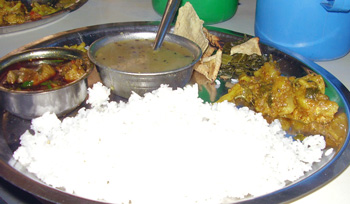 The national dish for most Nepalese is “Dalbat” which consists of rice and lentil soup. Here it is served in a more luxurious version with chicken necks, some potatoes, chard and pierogies. Students and staff eat dalbat for breakfast, lunch and dinner and then it is usually just rice and lentil soup with some vegetables.
The national dish for most Nepalese is “Dalbat” which consists of rice and lentil soup. Here it is served in a more luxurious version with chicken necks, some potatoes, chard and pierogies. Students and staff eat dalbat for breakfast, lunch and dinner and then it is usually just rice and lentil soup with some vegetables.
The school is surrounded on three sides and at the entrance there are gates that can only be opened from the inside. The school's male staff live on the ground floor, right next to the gates. In between there is a doghouse. The school dog has its territory there. Shendi is her name and on this day the dog has caught the chills and is receiving medicine to get well. Shendi is also good at hunting mice and rats. Together with the kitchen manager Ongchhu, she has caught a rat in the kitchen. Is that why Shendi got the chills? The staff found the dog the other year, at a rest area between the school and the capital. Shendi gets lots of pats and caresses, especially today when she is cranky.
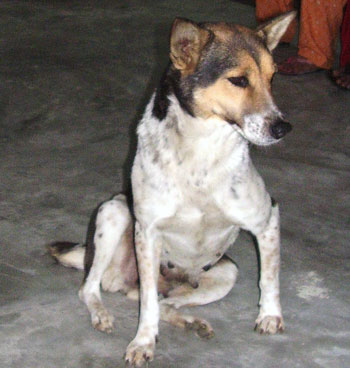 But Shendi is not just a companion dog and rat catcher. She will also warn if someone unauthorized tries to enter the school. We must not forget that many young women are at risk of trafficking. The school management has signed an agreement with the students' parents/relatives which means that they take over the responsibility for the students' safety during their studies. Each student has a personal ID card hanging around their neck.
But Shendi is not just a companion dog and rat catcher. She will also warn if someone unauthorized tries to enter the school. We must not forget that many young women are at risk of trafficking. The school management has signed an agreement with the students' parents/relatives which means that they take over the responsibility for the students' safety during their studies. Each student has a personal ID card hanging around their neck.
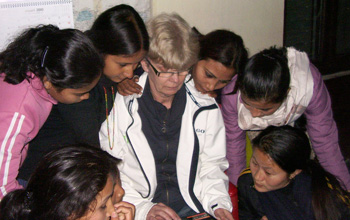 Anette takes lots of pictures with her system camera. Every evening we show the pictures on the laptop to those who are interested. The curiosity is palpable and the students crowd around the computer and Anette. They make many comments and are happy to ask if they don't understand what they are seeing. We have taken pictures outside the school and the classrooms as well. We feel very close to both the students and the staff and are increasingly understanding the way the school functions, not only as a boarding school and an educational institution but also as a home and a place where the students have great opportunities to develop. We are increasingly learning about the students' personalities and home conditions. The way of socializing at the school feels familiar, even between students and staff.
Anette takes lots of pictures with her system camera. Every evening we show the pictures on the laptop to those who are interested. The curiosity is palpable and the students crowd around the computer and Anette. They make many comments and are happy to ask if they don't understand what they are seeing. We have taken pictures outside the school and the classrooms as well. We feel very close to both the students and the staff and are increasingly understanding the way the school functions, not only as a boarding school and an educational institution but also as a home and a place where the students have great opportunities to develop. We are increasingly learning about the students' personalities and home conditions. The way of socializing at the school feels familiar, even between students and staff.
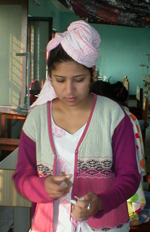 The school's housewife, Indira, plays a large part in this intimacy. She cleans the premises, helps in the kitchen, harvests vegetables and is like an extra mother to many of the students.
The school's housewife, Indira, plays a large part in this intimacy. She cleans the premises, helps in the kitchen, harvests vegetables and is like an extra mother to many of the students.
She lives just a kilometer away from the school in a one-room apartment and takes care of her five children and two of the children's cousins who are temporarily studying in the village of Odari. Her husband died a few years ago and life as a single mother is extra tough in Nepal. Her job as a housewife means a lot to the family's livelihood.
Rice is, as mentioned, the most important grain in Nepal, as well as in neighboring India. The school is somewhat self-sufficient by growing rice in the kitchen garden. The harvest is about 300 kg per year, but it only lasts for 20 days.
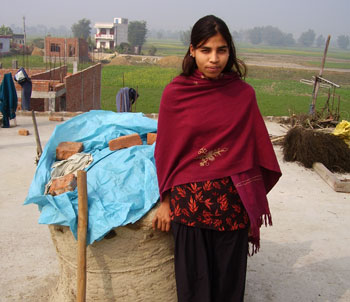 The rice is stored, to ripen, for a year in small “temporary barrels” made of clay, straw and thin bamboo sticks. We see such a barrel next to Pabrita (one of the school’s students), whose home we visited not far from the school. The barrel holds just over a cubic meter of rice and is protected from moisture, vermin, birds and pests during the storage period.
The rice is stored, to ripen, for a year in small “temporary barrels” made of clay, straw and thin bamboo sticks. We see such a barrel next to Pabrita (one of the school’s students), whose home we visited not far from the school. The barrel holds just over a cubic meter of rice and is protected from moisture, vermin, birds and pests during the storage period.
At Pabrita's house, the barrel is on the roof where it is exposed to the sun, with extra rain protection in the form of a plastic tarpaulin.
Nepal produces a lot of electricity from hydroelectric power plants, but the thinning glaciers in the Himalayan mountain range are resulting in low water levels in the rivers. India buys electricity from Nepal and it is perhaps this export that causes power outages for consumers to be as high as 11 hours every day. The outages can occur at any time of the day, which is why the school has its own diesel-powered power plant.
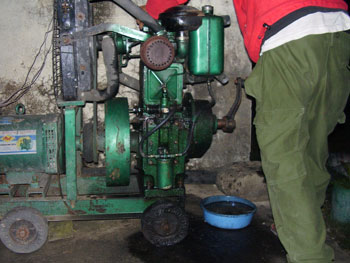 This power plant is probably not the most environmentally friendly option. The picture shows that oil is leaking onto the concrete slab, but this will be fixed later. Diesel oil is particularly harmful to groundwater. The power plant lacks a particle filter and is very noisy, which is clearly noticeable in the classrooms on the north side. The next day we moved the power plant to the west wall and the noise was significantly reduced.
This power plant is probably not the most environmentally friendly option. The picture shows that oil is leaking onto the concrete slab, but this will be fixed later. Diesel oil is particularly harmful to groundwater. The power plant lacks a particle filter and is very noisy, which is clearly noticeable in the classrooms on the north side. The next day we moved the power plant to the west wall and the noise was significantly reduced.
We meet in Nepal with an international expert on solar cells for electricity production. According to him, with series-connected solar cells in combination with today's newly developed batteries, it would be possible to produce electricity for at least refrigerators, fans and lighting. It is more difficult to also supply sewing machines with electricity from solar cells. This is actually the most urgent thing, but then a significantly larger investment is required, but this will have to be analyzed and evaluated. Perhaps we can find a Swedish sponsor for such a development?
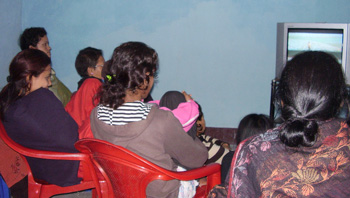 There is a TV room with DVD/Video player. This evening Sonam is showing the movie “2012″, an animated movie about the future, but the night before we watched a so-called Bollywood movie from India. These movies are very popular among the students. Another night we watched a comedy Nepali TV series that brought out hearty laughter among the students.
There is a TV room with DVD/Video player. This evening Sonam is showing the movie “2012″, an animated movie about the future, but the night before we watched a so-called Bollywood movie from India. These movies are very popular among the students. Another night we watched a comedy Nepali TV series that brought out hearty laughter among the students.
But suddenly the electricity goes out. The question is: Should we start the diesel generator? The answer is often: “No, we need the diesel for the sewing machines tomorrow.” This evening we go to bed instead and light a candle to prepare the rooms before bedtime. It’s eight o’clock in the evening!
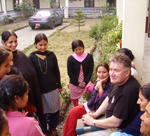 The sleep is good and at seven o'clock we hear the gong-gong. It is breakfast time, the nose is stuffy as it is only 15 degrees at night and the sheets are damp from the night dew that penetrates through the shutters. We sit at the breakfast table outside to catch some heat from the sun but it is very weak rays of sunlight that hit us. Someone says that they have hardly seen the sun since the end of November. There is constant fog or haze during at least the mornings and forenoons.
The sleep is good and at seven o'clock we hear the gong-gong. It is breakfast time, the nose is stuffy as it is only 15 degrees at night and the sheets are damp from the night dew that penetrates through the shutters. We sit at the breakfast table outside to catch some heat from the sun but it is very weak rays of sunlight that hit us. Someone says that they have hardly seen the sun since the end of November. There is constant fog or haze during at least the mornings and forenoons.
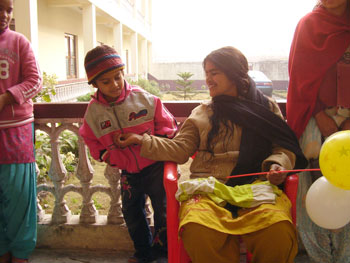 We are visited by a student who is currently a bit unwell and is therefore on sick leave. She comes with her daughter to meet Anette. The daughter has a sponsor in Sweden and Anette has something to hand over to her.
We are visited by a student who is currently a bit unwell and is therefore on sick leave. She comes with her daughter to meet Anette. The daughter has a sponsor in Sweden and Anette has something to hand over to her.
The daughter Bawana is very reserved at first, but after she got some balloons, things changed. We play with her. The balloons can function as both footballs and volleyballs. After a while, she dances for us. She has a wonderful rhythm in her dance.
“Bawana likes to dance, but so do many Nepalese,” says mother Basanti.
The students are called to the morning lineup with gymnastics, singing and yoga. Then Bosse accompanies them to the English lesson. Sonam has received both textbooks and colorful educational touch pictures from us. Bosse can communicate with the students by pointing at the pictures and using body language. The dialogue is exciting to experience.
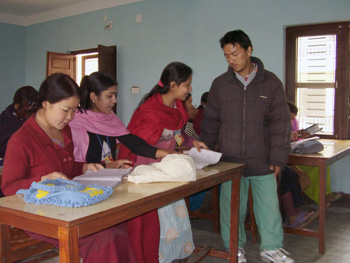 Sonam switches from one classroom to another. In the meantime, the teacherless students have self-study. Bosse takes the initiative and teaches in the classroom where the beginners are (they started at the end of October). The students are very study-oriented, writing, reading aloud, trying to have a dialogue in English and writing down a few sentences on one of the computers in the classroom.
Sonam switches from one classroom to another. In the meantime, the teacherless students have self-study. Bosse takes the initiative and teaches in the classroom where the beginners are (they started at the end of October). The students are very study-oriented, writing, reading aloud, trying to have a dialogue in English and writing down a few sentences on one of the computers in the classroom.
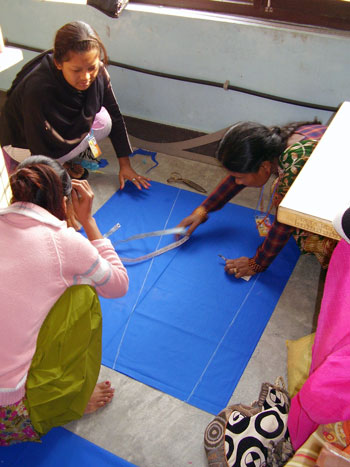 The sewing room is abuzz with activity. Some are drawing patterns and cutting out the pieces of fabric that will later become a garment. The students like to sit on the floor even though there is a good cutting table, like the one on the right.
The sewing room is abuzz with activity. Some are drawing patterns and cutting out the pieces of fabric that will later become a garment. The students like to sit on the floor even though there is a good cutting table, like the one on the right.
Others have sat down either at one of the 19 Japanese industrial sewing machines or one of the 5 mechanical machines made in China.
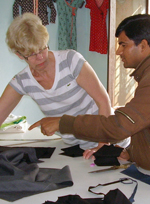 Anette will hand over patterns for pillow covers and pin cushions that we intended the students to practice sewing. Anette will then try to sell them at girls' gatherings and Lions meetings in Husqvarna and Jönköping.
Anette will hand over patterns for pillow covers and pin cushions that we intended the students to practice sewing. Anette will then try to sell them at girls' gatherings and Lions meetings in Husqvarna and Jönköping.
The students' eyes light up a little extra because of this. It means new tasks and new patterns. They are particularly captivated by the pin cushions, which look complicated. Even the assistant chef (etc.), Dendi, likes the pin cushions and asks if he can try making one. Anette thinks it's a good idea. He shows great talent when he makes a miniature model of the slightly larger pin cushion models. Anette is surprised that pins are not used to hold the pieces of fabric together before sewing. They do this "freehand", but maybe it works that way too? Well, that remains to be seen.
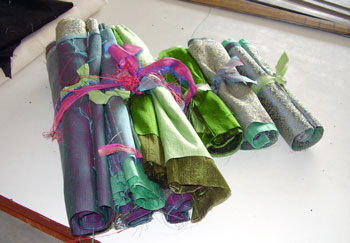 When the pieces of fabric are finished cutting, they are rolled up and a thin ribbon from one of the excess pieces is tied around the roll.
When the pieces of fabric are finished cutting, they are rolled up and a thin ribbon from one of the excess pieces is tied around the roll.
Doesn't it look nice when the colorful rolls of fabric are next to each other waiting to be picked up by one of the sewing machines?
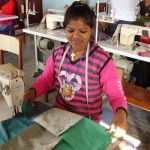 Shanta grabs one of the rolls and goes to her sewing machine. The pieces of fabric are rolled out, the presser foot is lifted up, lowered against the fabric and then she steps on the pedal. She manages to sew the pieces of fabric together without them slipping apart. At least that's what it seems. Maybe we're doing something unnecessary in Sweden? Or is it a lack of pins? Or simply a lack of time?
Shanta grabs one of the rolls and goes to her sewing machine. The pieces of fabric are rolled out, the presser foot is lifted up, lowered against the fabric and then she steps on the pedal. She manages to sew the pieces of fabric together without them slipping apart. At least that's what it seems. Maybe we're doing something unnecessary in Sweden? Or is it a lack of pins? Or simply a lack of time?
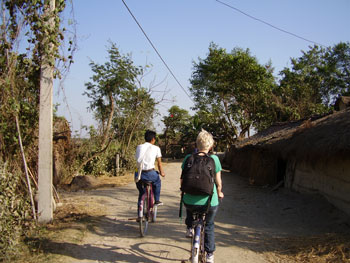 The next day, Ongchhu wants to show where he does his shopping and how it is done. They lack motor vehicles, so there will be a choice of walking or cycling. We choose cycling as it will be a trip of almost 20 km. The main destination is a lake where you can buy fish from time to time. It is Saturday and the students are off, so the English teacher Sonam comes with us. We cycle on small gravel roads out in the countryside. Still, the traffic is busy. We meet pedestrians, cyclists, moped riders and the occasional tractor. But we probably didn't meet a single car? The first stop will be a small local village market where Bosse buys whole black pepper. Otherwise, it will be "look but don't buy".
The next day, Ongchhu wants to show where he does his shopping and how it is done. They lack motor vehicles, so there will be a choice of walking or cycling. We choose cycling as it will be a trip of almost 20 km. The main destination is a lake where you can buy fish from time to time. It is Saturday and the students are off, so the English teacher Sonam comes with us. We cycle on small gravel roads out in the countryside. Still, the traffic is busy. We meet pedestrians, cyclists, moped riders and the occasional tractor. But we probably didn't meet a single car? The first stop will be a small local village market where Bosse buys whole black pepper. Otherwise, it will be "look but don't buy".
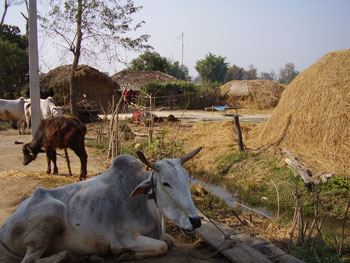 The tour continues through a few more simple farming villages. Anette stops at a farm where we are to hand over sponsorship money to a young student. A few minutes later he comes home, proud and happy when he sees Anette. The guy speaks excellent English and seems to be the pride of the family. We continue and see many water buffaloes, cows and many goats. They move leisurely so we can tentatively cross between them. Some farmers are busy threshing rice. It is still done according to thousand-year-old routines that are environmentally friendly as they are done manually. Out here in the countryside, everything comes to use, even the poop that is mixed with chopped straw and then dried in the sun, shaped into briquettes. The sight of our pale faces makes many people stop and look at us as we arrive on boys' bicycles (the frames are not large). What surprises us is that it smells good out there in the countryside, despite "cow scum" here and there.
The tour continues through a few more simple farming villages. Anette stops at a farm where we are to hand over sponsorship money to a young student. A few minutes later he comes home, proud and happy when he sees Anette. The guy speaks excellent English and seems to be the pride of the family. We continue and see many water buffaloes, cows and many goats. They move leisurely so we can tentatively cross between them. Some farmers are busy threshing rice. It is still done according to thousand-year-old routines that are environmentally friendly as they are done manually. Out here in the countryside, everything comes to use, even the poop that is mixed with chopped straw and then dried in the sun, shaped into briquettes. The sight of our pale faces makes many people stop and look at us as we arrive on boys' bicycles (the frames are not large). What surprises us is that it smells good out there in the countryside, despite "cow scum" here and there.
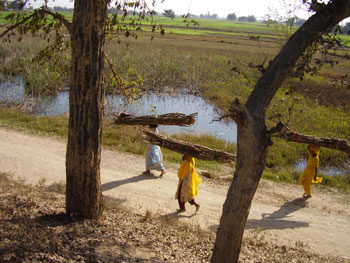 We see many people coming with huge loads of firewood. Some carry the firewood on their heads, others have the firewood stuck in their bicycle frames. We are told that it is about 15 km to the jungle. There, every citizen is allowed to collect firewood once a week for a fee of 5 rupees (50 öre). It is of course very tiring and usually a woman's job. There is no need for gyms and exercise trails here. At least we don't see the smoke from a single one!
We see many people coming with huge loads of firewood. Some carry the firewood on their heads, others have the firewood stuck in their bicycle frames. We are told that it is about 15 km to the jungle. There, every citizen is allowed to collect firewood once a week for a fee of 5 rupees (50 öre). It is of course very tiring and usually a woman's job. There is no need for gyms and exercise trails here. At least we don't see the smoke from a single one!
We arrive at a canal that leads water into an artificial lake. Here you can also fish with a fishing license. The lake is very important for the possibility of irrigating the rice fields, where up to three harvests can be harvested annually.
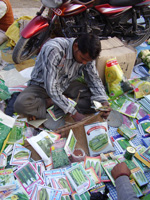 Soon we will be back in the village of Odari where we will buy seeds for the school's vegetable garden. It will be broad beans, corn, chard, etc. "Pigtails" are not found here in the market, but they are widely used as a salad by poor people who do not have their own garden. We finish with a good cappuccino and two pierogies each, which costs less than three kronor per person. That is a good measure of the cost situation here in Odari. But then the monthly salary is between 800-1500 rupees per month for a regular job. Temporary jobs pay less!
Soon we will be back in the village of Odari where we will buy seeds for the school's vegetable garden. It will be broad beans, corn, chard, etc. "Pigtails" are not found here in the market, but they are widely used as a salad by poor people who do not have their own garden. We finish with a good cappuccino and two pierogies each, which costs less than three kronor per person. That is a good measure of the cost situation here in Odari. But then the monthly salary is between 800-1500 rupees per month for a regular job. Temporary jobs pay less!
We cycle home and it's almost 4:00 PM. At school, the elves are waiting to go on a tip walk with us, but we also see Sonam helping some girls with their homework on this free Saturday afternoon. It's certainly ambitious!
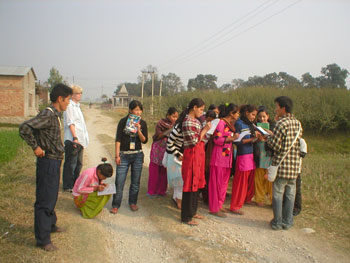 Bosse has, with the help of Sonam, designed 10 questions for the tips walk. Nothing like this has been experienced here, so there are many questions before the walk. We walk in a lemming train out through the gates and follow a small gravel road where the questions are gradually read out by Sonam. The girls are happy to help each other so that the answers are correct. No one seems to want to keep knowledge to themselves, but generously shares the answers.
Bosse has, with the help of Sonam, designed 10 questions for the tips walk. Nothing like this has been experienced here, so there are many questions before the walk. We walk in a lemming train out through the gates and follow a small gravel road where the questions are gradually read out by Sonam. The girls are happy to help each other so that the answers are correct. No one seems to want to keep knowledge to themselves, but generously shares the answers.
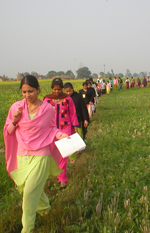 We also take the opportunity to look at rice fields, a small Hindu temple and meet many nice tractors. Ongchhu says that they are mainly used to transport stones from the riverbeds. The stones are used to build house foundations. Many new houses are being built in the area. It is mainly new residents who have acquired a small piece of land where they build their home, get a small shop, a café or some other place to eat. It is teeming with the spirit of a new builder and the population is very young.
We also take the opportunity to look at rice fields, a small Hindu temple and meet many nice tractors. Ongchhu says that they are mainly used to transport stones from the riverbeds. The stones are used to build house foundations. Many new houses are being built in the area. It is mainly new residents who have acquired a small piece of land where they build their home, get a small shop, a café or some other place to eat. It is teeming with the spirit of a new builder and the population is very young.
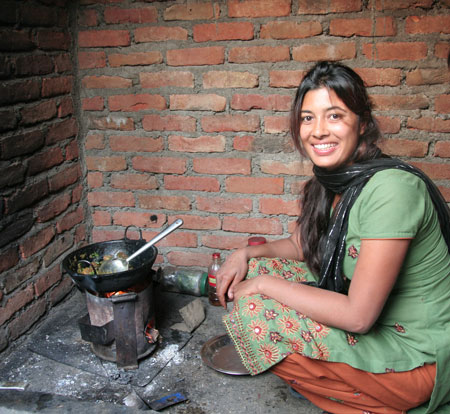 We are invited to the village of Odari where Bosse has her goddaughter. Her older sister is cooking dalbat “luxury” with good chicken parts. The cooking takes place in a pot on the corner stove. We had a delicious meal and enjoyed the company around us, about twenty neighbors.
We are invited to the village of Odari where Bosse has her goddaughter. Her older sister is cooking dalbat “luxury” with good chicken parts. The cooking takes place in a pot on the corner stove. We had a delicious meal and enjoyed the company around us, about twenty neighbors.
When we left the school, many tears ran down both our cheeks and the students'. A local bus took us to Kathmandu where we met with the school board. We reported our impressions and theirs. After the meeting, the board invited us to a large tent where we sat on floor mats and were served dalbat and wine. National dance groups offered a traditional dance performance. Anette stayed for another week to investigate job opportunities in Kathmandu and documentation. Bosse started her 38-hour journey home to the blizzard-ravaged Skåne. A week later, Anette managed to travel home in just under 16 hours, without delays.
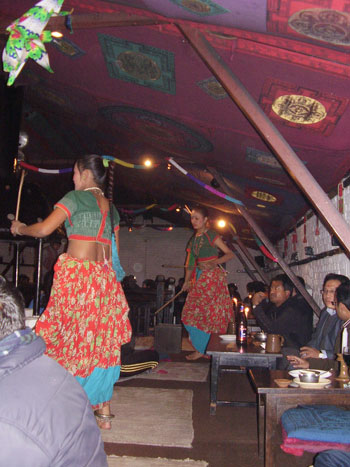 An unforgettable journey came to an end for both of us. If this travelogue is not enough, we are happy to share what we experienced but which is not reported.
An unforgettable journey came to an end for both of us. If this travelogue is not enough, we are happy to share what we experienced but which is not reported.


